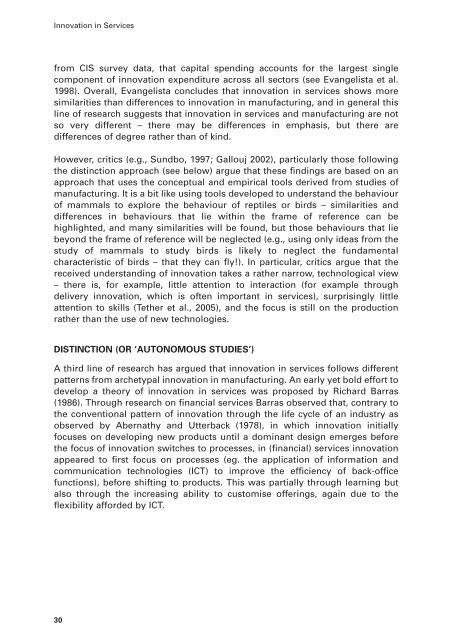Innovation in Services - Department for Business, Innovation and Skills
Innovation in Services - Department for Business, Innovation and Skills
Innovation in Services - Department for Business, Innovation and Skills
You also want an ePaper? Increase the reach of your titles
YUMPU automatically turns print PDFs into web optimized ePapers that Google loves.
<strong>Innovation</strong> <strong>in</strong> <strong>Services</strong><br />
from CIS survey data, that capital spend<strong>in</strong>g accounts <strong>for</strong> the largest s<strong>in</strong>gle<br />
component of <strong>in</strong>novation expenditure across all sectors (see Evangelista et al.<br />
1998). Overall, Evangelista concludes that <strong>in</strong>novation <strong>in</strong> services shows more<br />
similarities than differences to <strong>in</strong>novation <strong>in</strong> manufactur<strong>in</strong>g, <strong>and</strong> <strong>in</strong> general this<br />
l<strong>in</strong>e of research suggests that <strong>in</strong>novation <strong>in</strong> services <strong>and</strong> manufactur<strong>in</strong>g are not<br />
so very different – there may be differences <strong>in</strong> emphasis, but there are<br />
differences of degree rather than of k<strong>in</strong>d.<br />
However, critics (e.g., Sundbo, 1997; Gallouj 2002), particularly those follow<strong>in</strong>g<br />
the dist<strong>in</strong>ction approach (see below) argue that these f<strong>in</strong>d<strong>in</strong>gs are based on an<br />
approach that uses the conceptual <strong>and</strong> empirical tools derived from studies of<br />
manufactur<strong>in</strong>g. It is a bit like us<strong>in</strong>g tools developed to underst<strong>and</strong> the behaviour<br />
of mammals to explore the behaviour of reptiles or birds – similarities <strong>and</strong><br />
differences <strong>in</strong> behaviours that lie with<strong>in</strong> the frame of reference can be<br />
highlighted, <strong>and</strong> many similarities will be found, but those behaviours that lie<br />
beyond the frame of reference will be neglected (e.g., us<strong>in</strong>g only ideas from the<br />
study of mammals to study birds is likely to neglect the fundamental<br />
characteristic of birds – that they can fly!). In particular, critics argue that the<br />
received underst<strong>and</strong><strong>in</strong>g of <strong>in</strong>novation takes a rather narrow, technological view<br />
– there is, <strong>for</strong> example, little attention to <strong>in</strong>teraction (<strong>for</strong> example through<br />
delivery <strong>in</strong>novation, which is often important <strong>in</strong> services), surpris<strong>in</strong>gly little<br />
attention to skills (Tether et al., 2005), <strong>and</strong> the focus is still on the production<br />
rather than the use of new technologies.<br />
DISTINCTION (OR ‘AUTONOMOUS STUDIES’)<br />
A third l<strong>in</strong>e of research has argued that <strong>in</strong>novation <strong>in</strong> services follows different<br />
patterns from archetypal <strong>in</strong>novation <strong>in</strong> manufactur<strong>in</strong>g. An early yet bold ef<strong>for</strong>t to<br />
develop a theory of <strong>in</strong>novation <strong>in</strong> services was proposed by Richard Barras<br />
(1986). Through research on f<strong>in</strong>ancial services Barras observed that, contrary to<br />
the conventional pattern of <strong>in</strong>novation through the life cycle of an <strong>in</strong>dustry as<br />
observed by Abernathy <strong>and</strong> Utterback (1978), <strong>in</strong> which <strong>in</strong>novation <strong>in</strong>itially<br />
focuses on develop<strong>in</strong>g new products until a dom<strong>in</strong>ant design emerges be<strong>for</strong>e<br />
the focus of <strong>in</strong>novation switches to processes, <strong>in</strong> (f<strong>in</strong>ancial) services <strong>in</strong>novation<br />
appeared to first focus on processes (eg. the application of <strong>in</strong><strong>for</strong>mation <strong>and</strong><br />
communication technologies (ICT) to improve the efficiency of back-office<br />
functions), be<strong>for</strong>e shift<strong>in</strong>g to products. This was partially through learn<strong>in</strong>g but<br />
also through the <strong>in</strong>creas<strong>in</strong>g ability to customise offer<strong>in</strong>gs, aga<strong>in</strong> due to the<br />
flexibility af<strong>for</strong>ded by ICT.<br />
30
















